Daredevils Who Lost Their Lives During Insane Stunts
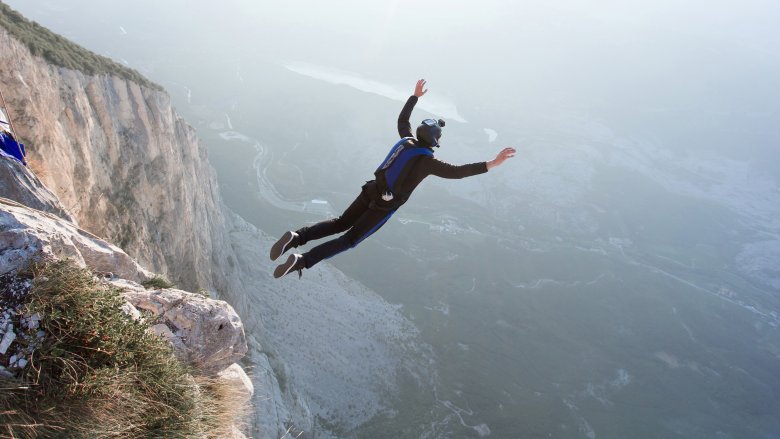
Shutterstock
By Becki Robins/
Human beings have been craving adrenaline since the first caveman dared the first lion to "catch me if you can." That's not to say that we all crave danger, but it's so much a part of our DNA that if we don't chase those thrills ourselves, we enjoy watching other people do it. If we didn't, YouTube probably wouldn't exist.
But daredevils, whether they're seasoned professionals or brash amateurs, aren't content to live vicariously through others, and their need to tempt fate comes with a price tag. Even the most accomplished daredevils, including Evel Knievel and Harry Houdini, barely escaped tragic accidents, while others have been far less fortunate. The awful truth about daredevils and their envelope-pushing stunts is that one day, their luck will run out, tragedy will strike, and loved ones will have to pay the price. Here are a few notorious examples of stunts that went horribly wrong.
Climbers Dean Potter and Graham Hunt died while base jumping
In a tragic base jumping accident, well-known climber Dean Potter (pictured) and his friend Graham Hunt died in Yosemite National Park when they jumped from Taft Point wearing wing-suits and crashed into a rocky ridgeline that Yosemite's chief of staff described as "spiny like a stegosaurus." This accident highlights the sad fact that experience doesn't necessarily protect you — Potter had made the exact same jump at least 20 times, and Hunt was probably similarly experienced.
Potter was well known in the extreme sports community and particularly well known in Yosemite, where climbing is a popular sport. He was the first person to "free climb" (using only hands and feet, although safety ropes can also be used) three-quarters of the way up Half Dome, the granite peak that is roughly 4,800 feet above Yosemite Valley.
He was also controversial — he'd been kicked out of Yosemite a couple of times for such crimes as sleeping in the meadow and breaking the stems off a head of broccoli in the park store. More telling, he'd lost a couple of sponsorships because of his increasingly risky stunts, such as climbing the Delicate Arch in the Arches National Park, and base jumping, which was just a little too dangerous for the popular brand Clif Bar to stomach. Other climbers expressed regret at Potter's death, but the words of fellow climber Doug Robinson may have summed it up best (per the BBC): "We're very sad ... but not very surprised. He was pushing the envelope all his life."
Kyle Lee Stocking went swinging
You know how television shows about daredevils always have that standard "don't try this at home" disclaimer? If only YouTube had the same requirement for their daredevil videos. Although seriously, just because some caption says "don't try this at home" doesn't mean people aren't going to try dangerous things at home.
According to ABC News, in March 2013, Kyle Lee Stocking attempted to duplicate a feat he saw on YouTube. If the stunt had gone as planned, the 22-year-old would have swung beneath the 110-foot Corona arch near Moab, Utah, after jumping off the top. But he misjudged the length of the rope he was using, and instead of swinging he struck the ground. The impact killed him.
The tragedy highlighted a growing problem of people trying to imitate stunts they see on YouTube, from swallowing cinnamon (which can give you a collapsed lung) to jumping off moving vehicles. While YouTube claims to prohibit content that encourages dangerous behavior, the video that inspired the fatal stunt is alive and well as of this writing. And still no "don't try this at home" warning, either.
Lim Ba had a heart attack while literally cooking himself in a steamer

The human capacity for dreaming up bizarre stunts is perhaps only surpassed by the public's desire to watch people do bizarre stunts, which is a pretty lethal combo when you think about it. In October 2017, the Daily Mail reported that Malaysian magician Lim Ba attempted a "human steam" stunt, which basically involved him sitting inside a giant wok with some rice and sweet corn. If the stunt went well, Lim would come out unscathed with some ready-to-eat grains, presumably to pass out to onlookers or something.
Lim was a veteran of this particular stunt — he'd been performing it for more than a decade, and his record was 75 minutes, according to the Independent. But he was also approaching 70, was being treated for high blood pressure, and had recently had a heart bypass. So really, he wasn't in peak physical condition at the time of his death.
Lim started knocking on the inside of the wok about 30 minutes into the performance. When onlookers removed the cover they found him unconscious, and by the time medical personnel arrived he was dead. The cause of death was a heart attack, though police also noted Lim had second-degree burns.
James E. Hickey set his parachute on fire

Shutterstock
In another base-jumping tragedy, 73-year-old James E. Hickey of Claremont, California, jumped off the Perrine Memorial Bridge (pictured) in Twin Falls, Idaho, and died. First, he set his parachute on fire. According to USA Today, Hickey was attempting to recreate a stunt he'd already successfully performed, only the last time he'd jumped from an airplane instead of from a 500-foot bridge.
If the stunt had gone as planned, Hickey would have set his first parachute on fire, then disconnected it, then deployed a second chute in order to float to safety. But something went wrong, and the second chute opened too late. A video showed a fireball engulfing both chute and jumper. According to the coroner's report, Hickey died of blunt-force trauma.
Per CNN, Hickey was an experienced base jumper who had completed more than 1,000 jumps over a 10-year period, thus proving once again that experience can't save you when the base-jumping grim reaper finally decides your time is up.
Sailendra Nath Roy used his hair for everything
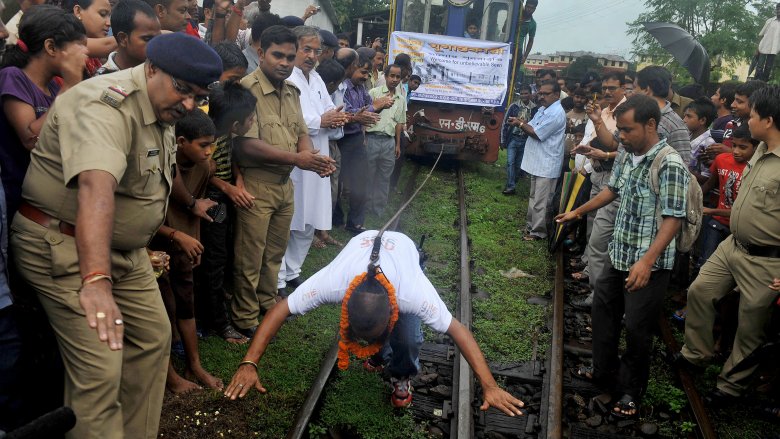
Getty Images
Some people are known for their super-strong arms. Some people are known for their super-strong legs. Sailendra Nath Roy was known for his super-strong hair. According to the BBC, throughout his pseudo-career as a daredevil (he also worked as a driver for the police department) he did a lot of crazy stunts with his hair, including pulling a narrow gauge train with his ponytail, which he claimed to keep strong with mustard oil and incredible feats of hair strength.
Roy held the Guinness record for farthest distance on a zipline using hair, so he wasn't new to the hairy circuit. But the 48-year-old might not have been in the best physical shape, and when something went wrong during his final performance, his heart was unable to withstand the stress. Spectators said he stopped moving down the zipline after about 300 feet. He struggled for close to 30 minutes, shouting for help, but there were no emergency personnel on hand and no one could understand what he was saying. At the end of the half hour, he became still. When paramedics finally cut him down, he'd already died ... of a "massive heart attack."
Officials said Roy didn't have permission to do the stunt, and if he'd had a professional support team on hand the outcome might have been different. Instead, the stunt he promised his wife would be his last really did end up being his last, but for all the wrong reasons.
Gigi Wu's solo hikes ended in tragedy

It's the social media era, and that doesn't just mean we all spend way too much time obsessing over the lives of people we haven't seen in 25 years — it also means it's really hard to stand out from the crowd because almost nothing hasn't been done before, and almost everything that has been done before has been posted somewhere on social media for the whole world to see.
Kudos to social media star GiGi Wu, who actually found a gimmick no one else was using: scaling mountains to pose in a bikini at the summit. She said she dressed appropriately for her hikes but would change her clothes at the top, so that's less crazy than the alternative, but still pretty wacky. She loved hiking alone and felt anyone should be able to do it, according to The Washington Post. Of course, that comes with safety concerns, and she even turned back from some hikes that she felt were unsafe for soloing.
The self-proclaimed "bikini climber" posted a lot of really impressive images of herself standing in treacherous places wearing clothing that's really only fit for a very warm (and flat) beach, but then something terrible happened. According to the BBC, Wu fell into a ravine while on a solo hike in Yushan National Park in Central Taiwan. She was evidently lucid enough to make a phone call after falling, though she said she couldn't move her legs. But rescuers weren't able to reach her until at least a day later, and by then she'd frozen to death.
Audrey Mestre smashed a record but couldn't get back to the surface

Free diving is the diving version of free climbing — it's done without equipment (more or less) and it's about a million times more dangerous than the version that's done with equipment. According to ABC News, roughly 2% of the free diving population dies every year — that's 100 deaths per 5,000 divers.
In 2002, free diving champion Audrey Mestre was trying to break the "no limits" dive world record of 531.5 feet. Everything went well until she was on her way back up. According to the Miami Herald, her cause of death was equipment failure — in no-limits free diving, an air tank fills a balloon, which helps the diver get quickly back to the surface. Mestre's air tank didn't have enough air in it to inflate the balloon.
The International Association of Free Divers gave Mestre a posthumous honor for the practice dive she'd completed a few days earlier — 558 feet, which was just 3 feet short of the dive that killed her. After her death her husband, Francisco "Pipin" Ferreras, swore off free diving, except for a single dive he said would be in her honor. In 2013 he changed his mind and said he'd come back for one more record-breaking attempt and then retire ... and then in 2017 he told GreenNews the same thing. And that's enough to give you some insight into the minds of extreme sportsmen — even knowing the risks, it's hard to give up the thing you love.
Decades of wingwalking experience couldn't save Todd Green

Getty Images
Extreme sports are always pretty terrifying and sort of insane — otherwise they wouldn't be called "extreme" — but wing walking has got to be right up there, surpassing "sort of insane" into the territory of "completely and utterly insane."
In 2011, wing walker Todd Green was performing at Selfridge Air Show in Michigan when he fell 200 feet to his death. According to CBS Detroit, Green was trying to transfer in midair from a plane to the skid of a helicopter when he slipped. Green's stunt was one of the biggest attractions of the show, and a lot of spectators initially believed the fall was part of the act — which seems to be a common misconception when daredevils die during performances. According to an Associated Press report (via the New York Daily News), It wasn't until the show's announcers told the crowd something had gone wrong that they finally learned the truth.
Green was the son of Hall of Fame aerial stunt performer Eddie "The Grip" Green and was following in his dad's footsteps. He had more than 25 years of experience performing aerial stunts.
Human cannonball Matt Cranch died when his safety net collapsed
The human cannonball is one of the world's most time-honored acts of putting oneself in great mortal peril for the amusement of others. According to Gizmodo, the first human cannonball took to the air in 1872, launching both himself and the careers of a long, distinguished line of people who ultimately died in the line of duty. Broken limbs, broken backs, and broken heads are fairly common injuries for human cannonballs — a fact that didn't stop Matt Cranch from signing up for a job with Scott May's Daredevil Stunt Show.
In 2011, Cranch was about to perform as a human cannonball for the first time, in front of a crowd of hundreds of people in Kent, England. He was shot 40 feet into the air, but his safety net collapsed on landing. He hit head-first and died from his injuries. As reported by the BBC, an inquest later found that the quick-release mechanism on the safety net hadn't been set properly.
Cranch was a former mechanic who had been on the stunt team for about a month at the time of his death and had practiced the stunt a total of five times. During the court case against the show's organizer, prosecutors argued that the quick-release mechanism wasn't even necessary for the stunt — a standard net set up prior to the incident would have done the job without risk of failure. The organizer received a £100,000 fine and a one-year "community order" for his part in Cranch's death.
Rapper Jon James found that wing walking is harder than it looks

YouTube
If there's anything that can be learned from the wing walking accidents of a bygone time (which is evidently like 2011), it's this: Don't walk around on the wing of an airplane, unless it's firmly parked on the asphalt. Even then, it's probably not an awesome idea because pilots tend to get mad when you walk around on their planes' wings without permission. But that's not a lesson that everyone has learned, and so recently there was yet another wing walking accident — this one in Canada, and the daredevil who did not survive the stunt wasn't even a professional stuntman.
According to CNN, a rapper by the name of Jon James thought a wing walking stunt would make for an awesome music video, but he wasn't exactly a trained stuntman and while he did train, he may not have had the kind of practice needed to safely perform death-defying stunts. Unfortunately, making a mistake while wing walking isn't quite like making a mistake while tap dancing — James walked a little too far out on the wing, which caused the pilot to lose control of the aircraft. The rapper tried to hold on as the Cessna went into a spin, but the effort was futile and by the time he let go he was too close to the ground to use his parachute.
The pilot regained control of the plane and landed safely. James was the only one who died.
Sam Patch was America's first daredevil
Americans have a long and noble history of innovation, creativity, and throwing ourselves over waterfalls for the amusement of others. The very first daredevil who did this was Sam Patch, who incidentally was also America's first daredevil in general. According to Atlas Obscura, Patch survived the leap into Niagara Falls twice, which is pretty impressive but not daring enough, evidently. Beating his own accomplishments was really the only way he could keep the public's attention (it's not like people were exactly lining up to challenge his title as "world's most insane waterfall man" or anything), so he had to keep upping the ante.
After Niagara become boring and passe, Patch decided to leap from the High Falls on the Genesee River, which was not quite as high up as the 125-foot platform he'd jumped from at Niagara but would at least bring in a new audience. And just to make the spectacle even more tempting, he promised to push a bear into the water first.
Somewhere between 6,000 and 8,000 cash-bearing people showed up to watch and everything went great, but Patch wanted more — specifically, more cash. So he scheduled a second jump, but this time, something happened mid-descent. Spectators said he "drooped," and then hit the water looking more like a marionette than a living person. And that was Sam Patch's last jump — his body was found 7 miles downstream four months later. The bear survived.
Kirk Jones went over Niagara Falls in an inflatable ball

Shutterstock
There's something about Niagara Falls that inspires daredevils, despite the fact that the ratio of survived to didn't-survive is roughly three to one. According to NY Falls, of all the daredevils who have attempted to go over the falls in some kind of vehicle (whether a barrel or a kayak), 16 survived and six died. That number doesn't include the dozen suicides that happen at Horseshoe Falls every year, or the 5,000-plus bodies that have been retrieved from the bottom of the falls since 1850.
On June 2, 2017, authorities found the body of Kirk Jones below the falls, but no one really seems to know much about his jump — Newsweek says tourists spotted "an inflatable ball" going over the edge in April, and police later found Jones' website, entitled "Kirk Jones Niagara Falls Daredevil." "Believe in the Impossible Kirk Jones + Misty Conquer Niagara falls NY 2017," the site announced. And who is this "Misty," exactly? That was Jones' pet boa constrictor, who was believed to have been inside the inflatable ball with Jones. The snake isn't thought to have survived, either.
And just in case all this talk about jumping off Niagara Falls has tempted you, surviving the jump is not only rare but also expensive — after brushing you off and sending you home, you can expect to get a bill for $10,000 in fines plus the cost of your rescue.
Nick Piantanida wanted to jump from the literal edge of space
Young adults are hardwired to do stupid and risky things, so when they get killed doing crazy stunts they saw on YouTube it's horribly, horribly tragic but sometimes not very surprising. When a 34-year-old dies doing something crazy, though, it's a little harder to understand.
In 1966, a New Jersey truck driver named Nick Piantanida decided for some reason that he was going to break the world record for falling from impossible heights, despite not really having any training or experience doing such things. Now, since this stunt can only happen at the literal edge of space, it seems like for most people it would remain a stupid pipe dream, but not for Piantanida. He was somehow able to find lots of enablers, including the senator who gave him a space suit, some other people who gave him money, and enough volunteers to help make the whole thing happen. According to Smithsonian Magazine, Piantanida made two attempts to ride a balloon into the sky, neither of which were successful. No one is really quite sure what happened on the third attempt, but before he reached the target altitude of 123,500 feet, ground control heard "a sudden hissing sound" followed by the first half of the word "emergency." The crew cut the gondola loose from the balloon and it floated to safety, but Piantanida was unconscious when it hit the ground. He died four months later without ever regaining consciousness.
[Featured image by Cliff via Wikimedia Commons | cropped and scaled | CC BY 2.0 ]
Janaka Basnayake buried himself alive as a stunt

Shutterstock
Jumping over stuff on a motorcycle or getting shot out of a cannon or leaping over Niagara Falls at least looks cool. You should never, ever try doing any of those things, but at least most people understand the motivations behind those particular acts of daring — it's the jaw-dropping, death-defying wow factor, and if it's accompanied by flames, loud noises, or bears, so much the better.
But sometimes people attempt stunts that aren't even visually impressive. Instead, they're just plain horrible to comprehend. In 2012, a 24-year-old Sri Lankan man named Janaka Basnayake dug a 10-foot-deep trench and buried himself in it. And what's more, his friends and family were all evidently on board with his plan, since they pitched in to help him out.
According to The Telegraph, Basnayake was attempting to break the world record for "longest time buried alive," and he wasn't actually a stranger to being covered with dirt for hours at a time — his previous stunts had lasted between two and a half and six hours. This time he was going for six and a half hours, but evidently that was around a half hour too long. When he was dug up at the end of the stunt he was unconscious, and he was dead by the time he arrived at the hospital.
Lowell Bayles was probably knocked out by his airplane's gas cap
Of all the stupid stunts people do, speed stunts are probably the most impressive and the most dangerous. Before the advent of cars, people tried to beat each other on foot, and then on horseback, and then while doing weird things like underwater archery or typing with your nose. So really it's more accurate to say that some speed stunts are dangerous and impressive, but definitely not all of them, unless the person who is typing on your keyboard with his nose has bird flu or something.
Anyway, according to Springfield Museums, 31-year-old Lowell Bayles set a new air speed record at 284.72 mph in December 1931, but because a timing device had failed, it didn't count. So Bayles tried again, but this time the attempt ended tragically. The plane took off and picked up speed, but before the official run began it "pitched upward," rolled, and crashed in a spectacular fireball.
No one is completely sure what happened, but the most popular theory is that Bayles got hit on the head with his own gas cap, which came loose during flight and incapacitated him. The theory seems to be supported by video footage of the craft, and by the fact that the gas cap was found loose some distance from the crash site, along with Bayles' goggles.
[Featured image by El Grafo via Wikimedia Commons |Cropped and scaled | CC BY-SA 3.0]
Karel Soucek was dropped from the roof of the Astrodome
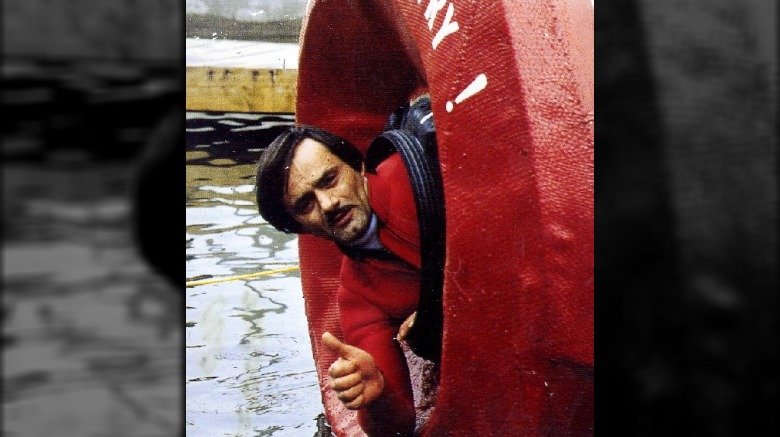
YouTube
It's kind of starting to seem like maybe Niagara Falls needs to answer for its crimes: It's supposedly killed approximately 5,000 people, while Mt. Everest, in contrast, has only claimed around 300. Granted, Everest does keep all its victims lying around like gruesome trophies, which is way more sociopathic than what Niagara does, but still, Niagara has some special powers — it can kill from a distance, sort of like Darth Vader only without all the one-sided banter during strangulation.
So how does Niagara do this? Well, surviving the descent over Horseshoe Falls is kind of miraculous, and people who experience miracles sometimes think they're untouchable. According to the LA Times, in 1984 37-year-old Canadian daredevil Karel Soucek went over Horseshoe Falls in a barrel, which must have given him some confidence because less than a year later he did the same basic stunt again, only this time from the top of the Astrodome into a 12-foot-wide water tank.
Overconfidence got him there, but the accident itself can be blamed on both the barrel's instability and the awesome power of an audience who kind of wants you to just hurry up already because it only has the babysitter until 9 p.m. "[The barrel] started spinning real bad," one worker told reporters. "After a while the people started getting so impatient that we went ahead and dropped him." But instead of plunging directly into the tank, the barrel hit the edge of the tank and crushed Soucek's chest, killing him.
Turkish scholar al-Djawhari thought he could fly

Shutterstock
Human beings dreamed of flight for centuries before the Wright brothers figured out how to do it. In fact it's probably safe to say that it's one of the core human ambitions, right behind becoming wealthy and eating as much chocolate cake as you want without having to worry about calories. So there really is a very long and distinguished list of people who have tried to conquer the skies in the stupidest ways possible.
A thousand years ago, though, you couldn't really blame people for thinking that all you need to achieve flight is a pair of wings somewhat similar to bird wings. So for most of human history you have accounts here and there of people who built wings, jumped off high places, and plummeted to their deaths. One of the earliest records of this comes from A.D. 1000 when Turkish scholar-turned-daredevil al-Djawhari built a pair of wings out of wood, climbed a mosque, and then died shortly after making an impassioned speech about how he was about to make history. So there you have it: It isn't just modern people who die in stupid, hopeful, arrogant ways. It appears to be built into our DNA.
Franz Reichelt invented a parachute suit that didn't work
A lot of people tried to improve on human flight, but most of the time the only real flying that occurred was when the bits and pieces of those carefully crafted wooden or feathered wings flew into the air upon impact. For some reason, it never occurred to most of these earlier aviators that they should maybe test their inventions on like a mannequin or a bear or something before actually strapping it to their bodies and jumping from the edge of a cliff.
According to the Vintage News, Franz Reichelt was an Austrian tailor who evidently felt that his profession specially qualified him to design aerodynamic clothing, since everyone knows pant legs and coattails must perform within certain specifications on a gusty day. Anyway it was 1912, and Reichelt had just invented the parachute suit, which was basically a flight suit with a parachute built into it.
Instead of testing the weird-looking thing on a dummy, though, he decided to test it on himself — this despite the fact he'd already broken a leg during an earlier, much lower altitude test. That earlier failure, he felt, was entirely due to not being tested from even greater heights, and he was so sure of this fact that he went up to the first stage of the Eiffel Tower and then jumped 187 feet to his death.
Jean-Francois Pilatre de Rozier and Pierre Romain were the first to die by balloon crash
As it turns out, a lot of people gave their lives during the early pursuit of flight, and it wasn't just in planes, gliders, and parachute suits. Early hot air balloons were also pretty temperamental — like "I'm going to catch fire and fall out of the sky now" temperamental, which you might not know is one of the worst kinds of temperamental there is, right behind "I'm going to explode now" and "I'm going to eat your liver with some fava beans and a nice Chianti."
The world's first deadly balloon crash happened in 1785, when a balloon operated by French balloonists Jean-Francois Pilatre de Rozier and Pierre Romain caught fire and sent its occupants plummeting to Earth. The cause of the accident was most likely a stray spark, although it might not have happened at all if de Rozier hadn't put hydrogen in his balloon, which does tend to get rather explode-y when you combine it with fire.
The accident was the first balloon-related fatality in the history of manned flight, so at least the two men are remembered, though probably not for the reasons they'd hoped.
Donald Campbell was killed trying to break his own record

YouTube
Speed records on land or in the air are cool and all, but it takes a special kind of crazy to tackle a speed record on the water. Because water may look all pleasant and summery and like it's inviting you in for a swim but what it really wants is to kill you.
According to The Guardian, in 1967 Donald Campbell was trying to beat the water speed record of 276.38 mph in a jet engine-powered boat called "Bluebird" when he "met some slight ripples." The boat's nose came up, and then it went over backward, somersaulted, and violently hit the water, sinking almost immediately.
The weird thing about this story is that Campbell seemed to have known what would happen if he pushed his boat too far — he'd once said that Bluebird could withstand less than 3 degrees of nose lift before it would flip, and he was certainly smart enough to know that excessive speed could make that happen. And here's the other half of the tragedy: Campbell died as the water speed world record holder, not because his fatal run had broken the existing record but because the existing record already belonged to him. That's right, he died trying to best himself.
Javad Palizbanian misjudged his abilities by several buses

Shutterstock
Evel Knievel was the Elvis of daredevils, with his bright white, star-studded jumpsuit complete with cape and curly chest hairs. But even Evel Knievel knew his own limitations — after he nearly killed himself while attempting to jump 13 buses with a motorcycle, he went on to complete a single record-breaking jump of 14 buses and then called it quits. Well, there was that one stupid jump over a tank full of sharks that he did after that, but that was too lame to really talk about.
Anyway, lots of people since then have tried to duplicate Evel Knievel's stunts, but 13 or 14 buses is just so 1975. According to the LA Times, in 2005 a 44-year-old Iranian daredevil named Javad Palizbanian decided to jump not 15 or 16 buses but 22, which would have really shown Evel Knievel (who was still alive at the time) who the true king of bus-jumping was, except that the stunt killed him. Ironically, he came down on the 13th bus, so not only had he misjudged his abilities by a full nine buses, but he also unwittingly duplicated Knievel's 13-bus accident at Wembley Stadium in 1975.
Wu Yongning fell from a 62-story building

Wu Yongning called himself "China's First Rooftopper." He was a martial-arts trained stuntman, but he was most famous for performing stunts without safety equipment on top of skyscrapers. According to USA Today, in 2017 Wu was performing on top of the 62-story Huayuan International Center in Changsha, China, when he slipped and fell to his death. Only the first 44 floors of the building are open to the public — Wu's girlfriend said he'd probably taken the elevator as far as it would go and then climbed the rest of the way.
Wu was an experienced stuntman who had completed similar feats hundreds of times and had made the equivalent of thousands of dollars from the videos he shot of himself performing. The stunt that ultimately killed him was reportedly worth 100,000 yuan, or about $15,000. As reported by the BBC, Wu's family believed that Sina News, one of China's major news outlets, had put up the money. His step-uncle said that Wu needed the cash for his mother's medical expenses and for his wedding. He had planned to propose to his girlfriend the day after his death.
Wu's death prompted debate in China over "close-to-death" reality videos, where people are encouraged to record themselves doing dangerous things in exchange for money and internet fame. Shortly after his death, Wu's stunt videos were removed from the two popular video services that had previously promoted them.
Jesus Mosquera and Sebastian Gamboa died wrapped in their nation's flag

Tatohra/Shutterstock
Sorry pilots, skydivers, and people who like to bounce really, really high on trampolines: Humans aren't meant to fly. Sure, we do it, and most of the time, we get away with it. But every now and then, we're reminded that we're really vulnerable up there, and when things go wrong, we can't just flap our wings and catch the next updraft to safety. Because we don't have wings.
In August 2019, Jesus Mosquera and Sebastian Gamboa were flying over Colombia's annual Medellin Flower Fair. They weren't in the helicopter, though — they were below it, hanging from a rope beside a huge Colombian flag. According to the Australian Associated Press, the pair were waving at the crowd when they suddenly fell to their deaths.
According to Spain's News, the commander of the Colombian Air Force later said that the rope they were clinging to didn't detach — it snapped. He also said that investigators had eliminated the possibility that the rope was worn or that safety procedures weren't followed, which sounds kind of like a roundabout way of saying, "It's not our fault."
Mohammed Jalaluddin set himself on fire for a chance to be a star

India's Got Talent
Reality TV has taught us one thing: Human beings will go to great lengths to achieve fame. Sometimes, people will even risk death for a shot at becoming a household name.
According to NDTV, Mohammed Jalaluddin, a 19-year-old man from Hyderabad, India, poured kerosene on himself and then set himself on fire. That sounds like an awful, awful suicide attempt, but that's not what it was — he was actually recording an audition video for a program called "India's Got Talent." In the first part of the stunt, he did a couple of fire-breathing tricks, and then he attempted something more dangerous: lighting his shirt on fire. Unfortunately, the fire raged out of control before Jalaluddin had a chance to remove his shirt, and his videographers were a bunch of neighborhood kids who ran away when things went south, leaving no one to help put out the blaze. Hindustan Times reported that Jalaluddin suffered burns over 60 percent of his body. He died three days later in a hospital.
For Christopher Serrano, Instagram fame was deadly
The problem with becoming known for shooting amazing images from dizzying heights is that you always have to top yourself. If you got a great shot from 15 stories high, then you need to get an even better shot from 30 stories high, and then you need to improve on that shot by climbing up the scaffolding on a construction site or dangling your feet off a ledge as the city buzzes along far, far below.
Christopher Serrano shared the photos he shot from atop tall buildings and bridges in New York City with his 106,000 Instagram followers. According to the tabloid The New York Post, Serrano was attempting a photo from the roof of a moving subway car when he was knocked off the train by an unknown object. He died on the tracks while his girlfriend watched helplessly nearby.
Serrano's last known image, captioned "It's lonely up here," was a shot of his feet dangling over Times Square from the top of a skyscraper.
Norjani the snake charmer was killed by (surprise) a snake

Shutterstock
"Snake charmer" is maybe not the right title for Norjani, an Indonesian man who was also known to locals as a "black magic shaman." We usually think of snake charmers as dudes in funny hats with flutes who play an entrancing tune to draw a cobra out of a basket. Well, that's not what Norjani did with the 16.5-foot cobra he caught in West Kalimantan, Indonesia. According to MSN, Norjani kept the snake in his hut for about a week before he brought it out to show to his neighbors, but not in a "let me lure it out with this flute" sort of way. Instead, he spun it around until it was good and angry and even laughed when it hissed and lunged at him. Unsurprisingly, the snake bit Norjani twice, once on his arm and once on his face. He resisted onlookers' efforts to help after the first bite and continued performing until after the snake delivered the second bite. Even then, he did not immediately seek medical attention.
Two hours after his weird impromptu performance, Norjani was taken to a hospital and given antivenom, but he'd waited too long to seek help. He died that evening. After his death, his family cut the snake's head off, which is kind of a tragic epilogue, really, given that the snake wasn't exactly the instigator in the whole horrible affair.
Ruben Carbonell jumped to his death in a Spanish cement factory
In yet another installment of things you should never do for YouTube fame, a Spanish YouTuber named Ruben Carbonell broke into a cement factory late one night and then filmed his own death.
The stunt didn't go the way Carbonell had planned it, unfortunately. According to Extra.ie, Carbonell and a friend jumped the fence at the Cemex Cement Factory (pictured) in Alicante, Spain, so they could shoot video of a dual parachute jump from the top of a 150-foot chimney. Carbonell went first, but his parachute failed to open. He fell to his death.
Carbonell's YouTube channel featured parachuting and paragliding videos and similar jumps from tall structures such as bridges. He had just 111 subscribers, so he was either trying to create some wild content to draw in more fans or he was okay with risking his life for a handful of likes. Either way, his death was an avoidable tragedy.
[Featured image by Vince Santini via Wikimedia Commons | Cropped and scaled | CC BY-SA 2.0]
Cameron Lancaster died trying to liven up the Ice Bucket Challenge

Shutterstock
Remember the Ice Bucket Challenge? That was like a couple of centuries ago in YouTube time, but for a while, it was a big thing. Except, one could get tired of watching random people pouring ice water on their heads and then gasping in miserable shock because, for some reason, it never seems to occur to anyone that ice is cold.
Anyway, 18-year-old Cameron Lancaster must have realized that being the 150 bazillionth ice bucket challenger would just make people yawn, so he decided to up the game. He completed the Ice Bucket Challenge and then followed it up with an 80-foot leap into an abandoned quarry. In his defense, there was water in the quarry, and evidently, kids would jump into it all the time. But something went wrong this time, and Lancaster landed in shallow water. His body was recovered four hours later.
Lancaster wasn't the first person to suffer the fatal consequences of a not-boring Ice Bucket Challenge — according to The Telegraph, just a few days before Lancaster's stunt, a woman attempted the challenge on the back of a horse and died after the animal threw her, because horses don't like having buckets of icy water dumped on them any more than humans do.
Shane McConkey died promoting Red Bull
There's a reason why today's Red Bull commercials are cartoons — cartoon characters can't accidentally die during filming. Well, that's probably not the entire reason, but we'd like to think that Red Bull has thought long and hard about including extreme sports athletes in their promotional materials after what happened to Shane McConkey. Probably not, but we'd like to think so.
According to CTV News, McConkey was an extreme skier and stuntman who was famous for doing alpine base jumps. The year before his death, he jumped nearly 1,500 feet above Whistler Valley during a grand opening performance for a ski gondola. Red Bull planned to feature him in a promotional movie, but something went wrong during the shoot. McConkey was supposed to release his skis after performing a double backflip off a cliff, but only one of them disengaged, and it became tangled up with the one that was still on his foot. McConkey managed to release the ski manually, but it was too late to deploy the parachute. He died on impact.
"He didn't have a death wish, he wasn't a daredevil, he wasn't stupid," his wife told Outside Online. "Whenever he did things, he calculated them beyond what anyone could imagine." And there's no indication that this jump was any different, which somehow makes the freak equipment malfunction that took McConkey's life that much more tragic.
Three more victims of social media fame

Shutterstock
One of the great tragedies of dangerous stunts is that other people sometimes die trying to come to the rescue of doomed daredevils. After Megan Scraper fell from the top of a treacherous waterfall, her companions tried to save her — and they died, too.
Scraper and her friends were members of High on Life, which promotes dangerous stunts in exotic places, doesn't discourage trespassing, and probably also doesn't encourage anyone to mind the posted "danger" signs. High on Life members usually document their crazy stunts with video or still photography, and it often ends up on social media. According to The Washington Post, Scraper, Ryker Gamble, and Alexey Lyakh were walking along the ledge at the top of Shannon Falls (pictured) when Scraper slipped and got caught up in fast-moving rapids. Gamble and Lyakh jumped in after her, but the current was too strong and all three of them plummeted about 100 feet. No one survived.
High on Life likes to promote the idea of "living life to the fullest," but members have been criticized for doing stuff that isn't just dangerous but also obnoxious, and the apparent goal seems to be more about grabbing a photo than "living life to the fullest." That doesn't make Scraper, Gamble, and Lyakh's deaths any less tragic, but please, people, if you really want to live life to the fullest, learn to knit, or something. Most people don't die from knitting.
Mike Hughes died for anti-science ... maybe?
Most of us don't need to build a rocket in order to know that the Earth isn't flat because the world has cameras and, you know, science. Still, there are some people who are convinced that it's all a big conspiracy, literally every scientist in the world is in on it, and the reason why they're all lying is because stuff. And things.
Mike Hughes was seemingly one of that handful of people who was convinced the Earth is flat, and he wanted the rest of the world to be convinced, too. So he built a rocket, which he launched from the California desert. But Hughes didn't just send up cameras — he wanted to see the flat Earth with his own eyes. Unfortunately, his rocket crashed shortly after launch, and he was killed before he could reach the hoped-for altitude of 5,000 feet. Hughes' publicist told The New York Times after Hughes' death that Hughes didn't actually believe the Earth was flat. "He was eccentric and believed in some government conspiracies, for sure, but it was a P.R. stunt" to raise money and attract attention, he said.
Hughes wasn't an amateur daredevil. According to the BBC, he'd successfully completed a lower-altitude launch the year before his fatal attempt, and he set a Guinness World Record in 2002 for the longest limousine jump. So his fatal accident wasn't necessarily because he was an inexperienced daredevil, and there was definitely an element of very, very bad luck.
Base jumper Uli Emanuele filmed his own death
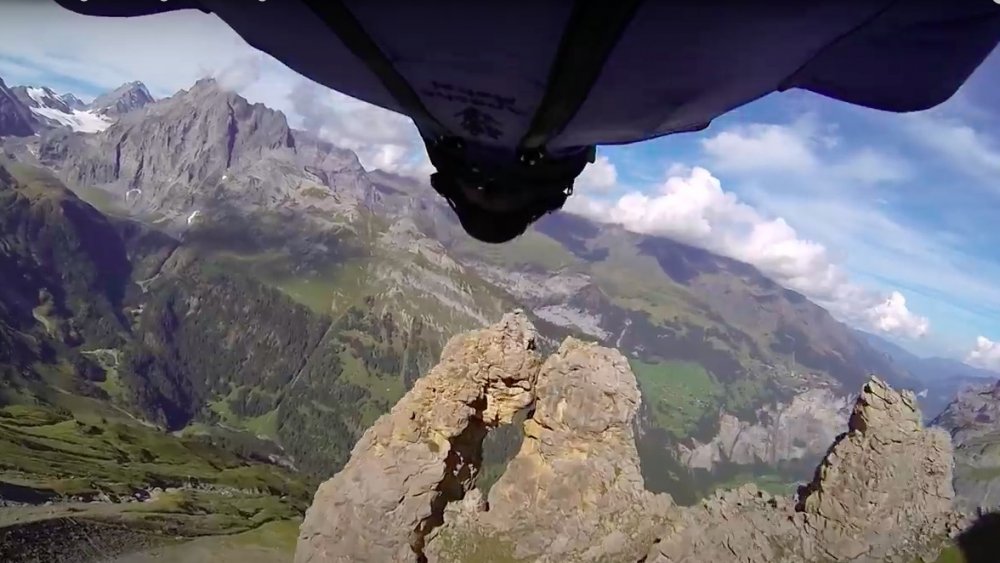
According to a study published in the Journal of Trauma, base jumping carries a one-in-2,317 risk of death. Sounds pretty safe, right? That's per jump, though, so if you jump 25 times a year for ten years, well, you'll probably like those odds a lot less. Let's just say your chances of dying are about 43 times greater than they would be if you just jumped out of a plane. Base jumping websites even admit it's dangerous. Heck, danger is part of the appeal. But it's also why we really shouldn't be surprised that there are so many deceased base jumpers.
Uli Emanuele was famous for a wing-suit jump through a 6.5-foot-wide crevasse in a Swiss mountain (pictured above), which is widely thought to be the most difficult wing-suit maneuver ever accomplished. But even the best base jumpers are vulnerable when they're flying around the mountaintops at speeds exceeding 100 mph, and Emanuele's luck ran out while he was shooting video for GoPro in the Dolomites. According to The Inertia, Emanuele lost control during a jump and crashed into the rocks before he could deploy his parachute. He was 29.
When Jessi Combs died she was the fastest woman on Earth

Frederick M. Brown/Getty Images
Here's a piece of advice: If you're going to break a world record, you should choose something like "heaviest weight lifted by a human beard," or if you lack the ability to grow a beard, maybe "most spoons stuck to a human body." Those are actual records, and as a bonus, if you broke one, you probably wouldn't die, though that beard one might be pretty uncomfortable.
According to AutoBlog, Jessi Combs set the land speed record for a four-wheeled vehicle in October 2013. Her jet-powered vehicle hit 398 miles per hour, but Combs wasn't satisfied. She made a few attempts to bust her own speed record and clocked more than 483 mph in those attempts, but the runs couldn't be recorded as records because of mechanical issues. Undaunted, Combs decided she was going to aim for 619 mph, which is a weirdly specific number, but okay. Ultimately, she wanted to beat Kitty O'Neil's land speed record of 512 mph, which had been set in a three-wheeled vehicle in 1976.
Combs was in her jet-powered car on a dry lake bed in Oregon's Alvord Desert when USA Today says the front wheel suffered a mechanical failure, causing the entire wheel assembly to collapse. Combs had accelerated to nearly 550 mph at the time of the failure. "People say I'm crazy," Combs wrote on Instagram just a few days before her death. "I say thank you."
Kostydin Yankov missed the safety net

Shutterstock
Joining student groups and other clubs is a pretty normal part of the college experience. You can join the French club or the theater club, or you can join the Oxford Stunt Factory if you really don't care if you ever graduate. What's the Oxford Stunt Factory? It's a self-described "dangerous and extreme sports club" for students of Oxford University. Kostydin Yankov was a member, though the club denied any part in the fatal event he traveled to in 2002.
According to Cherwell, the Oxford University student newspaper, the event featured a medieval-style catapult designed to fling humans instead of rocks or cows or whatever they used to fling with catapults in the actual Middle Ages. The first four participants made it to the net, but only just, and for some reason, that wasn't enough to convince event organizers that they might need to recalibrate the machine or, you know, move it closer to the net. Yankov missed the net completely, breaking his legs and spine. He died in the hospital later that day. To be fair, organizers were weighing participants and testing the machine with equally weighted objects, but that wasn't enough to save Yankov.
Three years later, a coroner concluded that the accident could have been avoided had there been additional safety tests. The accident could have also been avoided if event organizers weren't flinging live humans from catapults, but let's not spend too much time on the details, or anything.
Caleb Moore holds an unfortunate X Games title
Human beings love competitive sports. Human beings also love to watch other human beings do ridiculously dangerous stuff. The X Games, which have been held every year since 1995, are a happy union of the two — ridiculously dangerous competitive sporting events complete with gold medals, prize money, and mortal peril. Still, despite a large number of serious injuries, the X Games managed to get through quite a lot of years without any fatalities ... until Caleb Moore's freestyle snowmobile jump at the Winter X Games in 2013.
Moore was performing in the freestyle snowmobile competition when he attempted a backflip at a speed that was a little too slow for the maneuver. According to Deadspin, he under-rotated, and the snowmobile's skis dug into the snow, flinging him from the seat, which wouldn't have been so bad, except that the 450-pound snowmobile landed on his chest.
Still, it looked like Moore would be okay — he actually walked away from the scene. A few hours later, though, it became clear that the accident had damaged his heart. He went into cardiopulmonary arrest and died a few days later, becoming the first X Games fatality.
Extreme skier Alec J. Stall was pushed off a cliff by an avalanche

Shutterstock
There's not much — if any — risk of an avalanche on a typical ski run, but typical ski runs don't have the crazy descents that extreme skiers crave. When skiers leave the runs in pursuit of those unconventional skiing experiences, well, let's just say that no one can really predict how it's going to work out.
In the winter of 2005, four season pass holders at Vermont's Stowe Mountain Resort took the chair lifts to the top of the run, but instead of skiing down, they left marked trails and hiked to a dangerous location, where they planned to shoot an extreme skiing video for Meathead Films. According to The Barre-Montpelier Times Argus, Alec J. Stall was attempting to ski down a "chute formation" when he fell, landing approximately 30 feet from the edge of a cliff. He was trying to get up when an avalanche struck. The snow pushed him over the edge of the cliff, and he fell 500 feet to his death.
Neil Van Dyke, who was in charge of the search effort, said that the terrain where Stall died was so extreme that most skiers — even backcountry enthusiasts — avoided it. "In the 25 years that I've been doing this, this was the first time someone has died on that area of the mountain," he told the Times Argus.
Angela Madsen died alone in the Pacific Ocean

John Gichigi/Getty Images
Sixty-year-old Angela Madsen was a Paralympic rower and an inspiration for anyone trying to come back from a serious injury. Madsen was injured while playing basketball in 1981, and a botched surgery cost her the use of her legs. In 1997, she became a competitive rower, and in 2012, she won a bronze medal at the Paralympic games.
Madsen's ambitions went a long way past competitive rowing, though, and in 2007, she became the first woman with a disability to row across the Atlantic ocean. Then, in 2009, she became one of the first two women to row across the Indian Ocean. She then set her sights on the Pacific. This time, she planned to go solo.
Madsen died 60 days into her attempt to become the first paraplegic, first openly gay, and oldest woman to row across the Pacific Ocean alone. In her last communication, she'd mentioned that her boat needed repairs, but by the next day, she'd fallen silent, and tracking data indicated that the boat was not being rowed. The Coast Guard found her floating in the ocean on June 22, 2020, still tethered to her boat. So far, no one knows the circumstances that led to her death.
A speedometer malfunction might have doomed Butch Laswell

Shutterstock
High-speed vehicles are super dangerous, but high-speed motorcycles can be lethal because you can't put airbags in them and can't wear a seatbelt. (And if you could, well, that totally wouldn't help you much.) So people who do motorcycle stunts are painfully aware of the possibility of death, but even that kind of risk can be micromanaged. When you ignore just one or two of the variables, that's when you're most likely to get in trouble.
According to the Las Vegas Sun, Butch Laswell performed more than 6,000 successful motorcycle jumps during his career, but before his last one in 1996, he remarked to a friend that his speedometer wasn't working and that he was concerned about the wind. The jump was pretty nail-biting, even compared to other motorcycle jumps — Laswell planned to jump over a 38-foot-tall pedestrian walkway and land on a ramp that he couldn't even see because the walkway would obscure it until he was over the top. Despite his concerns, Laswell went ahead and did the jump anyway. Investigators say he was going at least 85 mph when he jumped (10 mph faster than he was supposed to go), and spectators said that it appeared as if the wind had pushed him off course. He fell 65 feet onto the pavement and later died from his injuries.
Someone sabotaged magician Arnold Buck's bullet-catching trick

Shutterstock
You probably thought the title for "most dangerous magic trick" would be held by something really dramatic, like escaping from a steel box in shark-infested waters or something, but no, it's the bullet-catching trick. According to MagicTricks.com, at least 15 people have died trying to do this trick, and every incident is slightly different. One of the worst, though, is the death of Arnold Buck in 1840.
Buck performed the bullet-catching trick with a blank, but to give the trick some credibility, he would usually have an audience member load up the gun with the blank bullet. Well, on the night of his last performance, he chose a volunteer who was like, "Haha! I will prove to the world that Arnold Buck is a fake by loading this gun with nails instead of a blank bullet!"
Now let's just pause for a moment to consider the thought trajectory that has to happen in order for you to think this is a great idea: You haven't decided to load the gun with silly string or whipped cream or something that will merely embarrass the magician — you've decided to put something in there that will kill him. And then you fire the gun at him, knowing he will probably die. And that's exactly how Arnold Buck went out. No one seems to remember what happened to the guy who killed him.
Aimo Leikas killed himself doing a Russian roulette act

Orlando/Getty Images
Russian roulette isn't so much a stunt as it is just extreme stupidity. This is the game you think about when you imagine drunk, reckless, mostly suicidal 18-year-olds daring each other to do increasingly idiotic things. But for Aimo Leikas, Russian roulette wasn't just a really, really stupid party trick, it was his signature trick. The Finnish magician had been doing the same Russian roulette trick on repeat for a least a year and had somehow always managed to avoid killing himself.
According to Casino.org, Leikas' version of the trick involved six bullets, some of which were supposedly real and some of which were supposedly fake, and all of which were unmarked. Leikas claimed he had a psychic ability to know the difference when he was selecting the bullets out of the box.
Now, it's unclear if he usually did this trick with some actual live bullets. On the other hand, it seems like you could only avoid fate for so long if you were using live bullets, so who knows. At any rate, in 1976, Leikas' luck either ran out, or someone accidentally put a real bullet in the box. Or maybe on purpose. Either way, he shot himself to death in front of a crowd of spectators.
Alex Harvill tried to break a motorcycle-jump record

Shutterstock
It seems like world records should reach a sort of point of no return, like there's an invisible barrier that's just impossible to cross, and an attempt to break the record will mean certain death. After all, it's possible for a motorcycle to jump 351 feet, which is the current record "from a moveable launching ramp to a dirt landing ramp," and there's no way that a motorcycle could ever jump, say, an entire mile, so there must be some point somewhere in between that it's just not possible to go beyond.
We probably won't know where that point is until more than one person has tried — and failed — to cross it. We do know that attempting to break the current record is dangerous, though. Alex Harvill died in June 2021 during a practice jump just before he was due to make a public attempt on the record at the Moses Lake Airshow in Washington. According to the Columbia Basin Herald, the 28-year-old died from "blunt force trauma to the torso" after he came down just a little bit short of the landing mound (via WATE).
There's no way that anything good can come out of such a tragedy, but air show organizers did say they planned to share proceeds from the event with Harvill's widow and two children, so that's a very small something, at least.
Yoshiyuki Takada died while performing the Dance of Birth and Death

Shutterstock
Most people don't think of dance as being especially dangerous. You can bust an ankle while busting a move or bang your head into your partner's, but there aren't usually a whole lot of fatalities attributed to dance moves gone wrong. In 1985, though, the Japanese dance troupe Sankai Juku proved that dance can be an extreme sport, too, when dancer Yoshiyuki Takada died during a performance of a "Dance of Birth and Death" in Seattle's Pioneer Square. As reported by UPI, the dance's metaphor for life and death became way, way more than a metaphor when the dancers hung themselves upside down from the fifth story of a building and Takada's rope broke.
According to History Link, Takada seemed to immediately know something was wrong — he looked up at his rope as it was starting to fray and made the beginnings of an attempt to climb back up to safety, but there wasn't enough time. The rope unraveled, and he fell 80 feet to his death.
Human error was once again to blame, only in this case, it was sort of like semi-deliberate error. Incredibly, the troupe preferred to use old rope because old rope is more stable and doesn't tend to twist. That's okay if the ropes are strength-tested before the performance, but the troupe only did that with one of the four ropes used in the act — and it wasn't the one Takada was using.
Movie stuntman Dar Allen Robinson suffered a gruesome fate

Shutterstock
By now, we're all in agreement that motorcycles are dangerous, even when you know exactly what you're doing, you're not trying to break a record, and you're widely considered to be one of the best stuntmen in the business. Because work accidents happen all the time — the only difference is that some of us get paper cuts, and some of us die.
Dar Allen Robinson was a professional stuntman at the peak of his career in 1986 when he died doing a pretty routine motorcycle stunt for a movie called "Million Dollar Mystery." Robinson was no wannabe — he held the records for the highest fall onto an airbag, the longest ramp-to-surface jump in a car, and the highest fall while on fire, so the fact that he was still alive tells you he knew what he was doing.
Weirdly, the stunt that killed him was a simple maneuver where he was supposed to take a turn at 50 mph at the edge of an embankment. Sure, that doesn't sound simple for someone who doesn't do motorcycle stunts for a living, but for Robinson, it was just another day at the office ... until he lost control of his bike and fell down the embankment. Still, it wasn't the fall that killed him, it was the landing. According to the Los Angeles Times, Robinson hit a rock ledge and was impaled by a branch. He died on his way to the hospital.
Actor Jack Randall died filming a Western

Shutterstock
You might imagine horses are safer than motorcycles because they don't go as fast, but the real difference is that motorcycles don't buck just because they feel like it or jump 10 feet into the air when a piece of paper floats by. Unlike motorcycles, horses don't always do what they're told, and that can lead to disaster.
There are a couple of different versions of the accident that killed actor Jack Randall in 1945, but they all involved a horse. In one version, he had a heart attack and then fell off his horse, so if that was true, it would be unclear if it was the horse or the heart attack that actually killed him. According to B-Westerns, that's not the real story: Randall's death certificate says he hit a tree after being thrown from his horse, but even so, there are still a few conflicting accounts of just what caused the ride to go south.
In one story, a piece of paper blew in front of the horse, and the animal freaked out, as horses do. In another version, Randall was trying to retrieve his hat after it blew off during a "running insert" (which, in this case, is not one of those squishy things you put in your shoe before you go jogging but a cinematic term for a tracking shot), and he lost control of the horse. If the third story is true, that's a pretty insane stunt with a tragic conclusion.
Henry Roland missed his trapeze
You probably thought the whole free climbing/parkour thing was something people only recently started doing, you know, because of the boredom of modern life and the fact that they can put it all on YouTube. But climbing tall buildings is kind of a time-honored tradition, dating back to, well, the invention of skyscrapers. Probably. History doesn't remember every single person who has ever climbed to the top of a tall building, but it does remember the ones who fell.
German-born daredevil Henry Roland called himself "The Human Fly" because of a fly's uncanny ability to stick to vertical surfaces. According to The Greenville Sun, Roland was a seasoned stunt performer with more than 21 years of experience with "climbing and balancing stunts" and a history of surviving only semi-survivable accidents. He even had his wife take part in some of his stunts, like the time she sat on his shoulders while he walked blindfolded on the edge of a building. That's some marital bliss for you.
Roland's luck ran out on October 8, 1937, when he climbed to the top of a 20-foot pole that was attached to a 90-foot ladder and did a bunch of balancing and swaying tricks, to the delight of the crowd below. To complete his trick, he was supposed to grab onto a swinging trapeze, but the wind blew the trapeze out of his reach and he fell to his death instead.
Ormer Locklear was killed when a biplane stunt went spectacularly wrong
Ormer Locklear was a daredevil from childhood — according to Hometown by Handlebar, he once attached a motorcycle to a pulley and rode it to the top of a four-story building. As a kid. In 1911, at the age of 20, he built a glider and tried to fly it from the roof of a local high school. It crashed, so he built another one. The second one made it into the air. From there, he embarked on a lively career of almost killing himself time and time again, until 1920, when he did actually kill himself during a stunt for a movie called "The Skywayman."
The stunt, as it was planned, was pretty terrifying, especially when you consider that 1920s safety standards basically consisted of praying and hoping. Locklear was supposed to put his Jenny biplane into a spin while another man lit flames to simulate an engine fire. The stunt began at an altitude of 10,000 feet and was supposed to end at 2,000 feet, at which time Locklear would regain control of the plane and land safely.
That's not what happened, though. The plane continued to spin until it reached an altitude of 200 feet, and when Locklear finally tried pulling out, it was too late. The plane crashed, and both men died. The prevailing theory is that the movie lights that were pointed at the plane blinded Locklear, so he didn't know how close he was to the ground.
Samuel Gilbert Scott should have just stuck to high diving
Compared to getting into a barrel and having yourself rolled over the edge of Niagara Falls, high diving seems sort of tame by comparison. But remember that diving is a pretty precision activity — if you don't do it right, you could break some bones because when you're jumping from way up high, water isn't really that much different from concrete.
Samuel Gilbert Scott made his living as a high-diver. According to History House, Scott was a former sailor who probably unlearned any fear of heights he might once have had while working at the tops of ships' masts. After leaving the U.S. Navy, he transitioned those skills into daredevil performances where he would climb to the top of a ship's mast, do some acrobatics, and then dive into the water. Since daredevils need to do increasingly daring things lest their audiences get bored, he soon expanded his repertoire to include jumps from bridges, piers, and chimneys.
Once diving started to become old hat, he decided it would be fun to wow the crowd by pretending to hang himself. Only on January 11, 1841, he wasn't just pretending — in front of a crowd, he hanged himself from Waterloo Bridge and was dead before the crowd realized it wasn't a part of the act. Though it seems like it could have been deliberate, most sources agree that Scott's death was a tragic accident.
[Featured image by Wellcome Images via Wikimedia Commons | Cropped, scaled, and mirrored | CC BY 2.0]
Seawalls are not bike paths

Shutterstock
BMX bikes used to be a fun thing for kids to do on the weekends, and then along came YouTube. Now BMX bikes are a good way to get likes and a great way to get yourself killed.
In August 2019, a man in his 30s (who should have known better) was doing BMX bike tricks on a seawall near the Vancouver Harbour Flight Centre in Canada while his brother filmed him. According to CTV News, he was attempting to jump between platforms when he miscalculated and fell nearly 30 feet into the water; Vancouver Is Awesome claims he hit his head on a concrete embankment on the way down. Witnesses said a bystander tried to help him by jumping over the seawall onto the dock, breaking both ankles on impact. Despite his injuries, the bystander was able to pull the man from the water, but it was too late to save him.
Pedro Ruiz III (mistakenly) thought a thick book would stop a .50-caliber bullet

Shutterstock
There are many problems with doing stunts for the YouTube audience, but probably the biggest is that YouTube daredevils often do their acts sort of off the cuff, with no planning or preparation, just an incredibly dangerous idea. By contrast, most modern stunt performers have worked on their acts for months, practiced them in less dangerous ways before moving on to the real thing, and often rely on other people to double-check the conditions and the math so they can be reasonably sure that yes, this stunt, if performed correctly and with safety in mind, will not kill the performer.
Unfortunately, Pedro Ruiz III, father of two, didn't think to test his bulletproof book theory before holding it against his chest and asking his pregnant girlfriend to shoot. According to the Grand Forks Herald, Ruiz believed the book was thick enough to stop a .50-caliber bullet and coaxed his reluctant girlfriend into pulling the trigger. She later pleaded guilty to charges of second-degree manslaughter in exchange for a six-month sentence. "Nitro Circus, Jackass ... that's who I look up to," Ruiz said in the video, just before his death. "My purpose is to be crazier than them." Well, that much he did accomplish, anyway.
Aviation pioneer Lincoln Beachey seemed immortal, until he didn't
Lincoln Beachey was an early aviation pioneer, and let's face it, you had to have some cajones to be one of those guys, flying around in a biplane made from sticks and fabric. Beachey got his start in dirigibles but soon moved on to airplanes, and he immediately impressed the aviation world by figuring out how to get out of a death spiral, which, at the time, was considered to be pretty certain death.
Incidentally, Disciples of Flight says it was Beachey who was responsible for the skyrocketing number of airplane-related deaths in the early part of the 20th century, as stunt pilots everywhere tried to copy his tricks. While everyone around him was dying attempting to do his stunts, Beachey seemed immortal, until he wasn't. In 1915, not long after he became the first American to successfully fly a loop in an airplane, Beachey was killed while attempting an inverse loop at 3,000 feet. The plane stalled, and Beachey tried to regain control with a maneuver that ended up ripping the wings right off of the plane.
Beachey crashed into the San Francisco Bay, but he didn't die — at least not immediately. According to the coroner, his only injury was a broken leg, and what killed him was the safety harness. Unable to escape, Beachey ended up drowning while still strapped inside his plane.
Roy Fransen's fiery Dive of Death lived up to its name
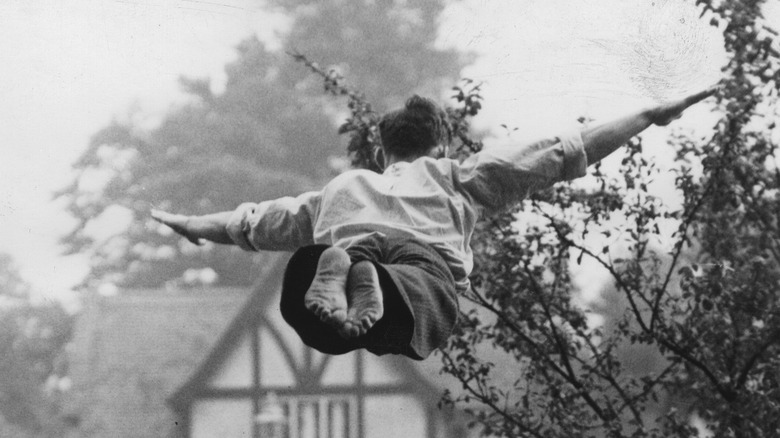
Brandstaetter Images/Getty Images
Saturday morning cartoons, if you're as old as dirt and you remember such things, used to occasionally feature cartoon rabbits or coyotes jumping from impossibly high diving boards into tiny little barrels, which always ended in hilarity. But people don't do that in real life, do they?
Here's a funny little fact for you: Shallow diving, which is the official name for the sort of thing that figured into the occasional Saturday morning cartoon, was actually a thing (and still is, believe it or not). According to How Stuff Works, it's basically just a giant belly flop into shallow from way up high. The shallow water and the awkward (and painful) presentation as you hit it saves your neck from breaking, though evidently it's exactly as painful as it sounds like it must be.
Anyway, Roy Fransen (pictured) was famous for his shallow dives, but he was most famous for the fact that he would light himself on fire just before doing a shallow dive. He cleverly named his act "The Dive of Death" (because what else), and he kept doing it for years. You'd probably think this guy's career was pretty short-lived, but it actually wasn't. Fransen wasn't done in by his bizarre profession until 1985, when he was 69. Fittingly, he died performing the Dive of Death.
Trick rider Otto Kline lost his grip
It takes a pretty well-trained horse to not completely lose its mind when a rider starts doing bonkers tricks on its back at high speeds. This was an art form that kind of evolved in America during the Wild West era, though Russian Cossacks had been doing these kinds of mounted tricks during battle for centuries. If it looks dangerous to you, that's because it is. If you don't have a pretty bulletproof horse, your chances of death increase exponentially.
It sounds like Otto Kline did have a pretty bulletproof horse, but things still went wrong for him on April 21, 1915. According to The New York Times (via the Illinois Gravestone Photo Project), Kline was doing a trick that involved launching himself from one side of the horse, over the saddle, and onto the other side, all while the horse was moving along at a nice, terrifying clip. But his hand slipped off of the pommel and he was flung into an audience box, striking it with his head. He died a couple of hours later at the hospital without ever regaining consciousness.
Incidentally, his horse, who was very well trained indeed, stopped in her tracks as soon as she lost her rider. So in this case, at least, it's totally not the horse's fault.
[Featured image by Jklin via Wikimedia Commons |Cropped, scaled, and mirrored| CC BY-SA 2.5]
Stephen Hilder's death was a tragic skydiving accident... or maybe not
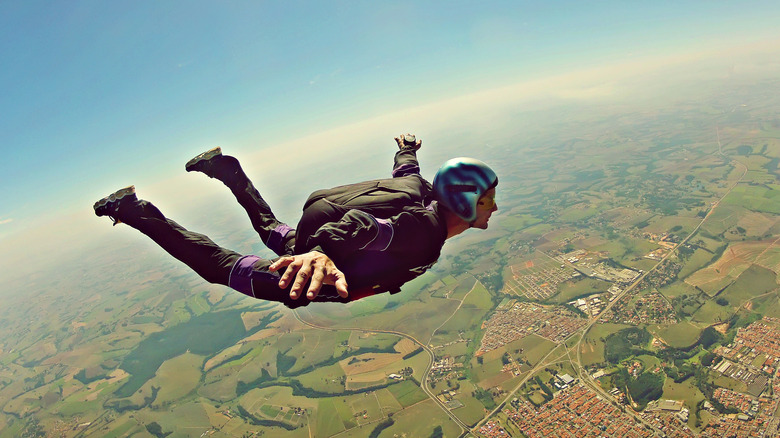
Shutterstock
Skydiving is actually common enough now that it doesn't seem super insane all by itself. In fact, it seems kind of boring and routine until you actually get up there and start questioning all of your life choices and saying things like, "This is insane," under your breath. Most of the time, skydivers are fine. After all, there's a chance one of your chutes might not open, but the chances of both of them failing are a lot like winning the lottery.
Fatal skydiving accidents do happen, though, and they can even happen to professionals like Stephen Hilder, though "accident" is totally the wrong word because everyone is pretty sure Hilder's death wasn't an accident.
According to the Independent, in 2005, Hilder was performing with a team of fellow skydivers at a competition at London Heathrow Airport. The team jumped from 13,000 feet, did a series of aerial displays, and then prepared to open their chutes at 4,000 feet. But Hilder's chute didn't open, and neither did his spare, which is an accident that almost never happens in skydiving. Investigators later discovered that both chutes had cords that had been cut by a pair of scissors discovered in Hilder's car. The scissors had just one person's DNA on them: Hilder's, so it remains unclear if his death was self-inflicted or if there was an extremely elaborate plot to make it look like it was.
Robert C. Landeta's Brooklyn Bridge climbing stunt ended in the worst possible way

Eloi_omella/Getty Images
Bridges tend to be for crossing instead of climbing. Even so, thanks to their often-imposing design and ample support structures, every once in a while a person gets it in their head to reach the top. This, of course, can be highly dangerous — and on April 2, 1999, Robert C. Landeta found this out the hard way (via The New York Times).
The New York City resident planned to scale five different bridges in just four hours. His first target was the iconic Brooklyn Bridge, but as it turned out, it was also his last. After using one of the bridge's suspension cables to climb over 100 feet above the deck, he slid down and fell all the way down to the unforgiving ground some 250 feet below.
Landeta was a 27-year-old who had no previous history as a daredevil. His bridge-climbing stunt apparently stemmed from a desire to perform a record feat that would earn him a spot in the Guinness Book of World Records.
Remi Lucidi's final skyscraper climb went tragically wrong
Remi Lucidi, aka Remi Enigma, was a popular urban climber who had gained notoriety for the pictures he posted about his dangerous endeavors across the world. Per the South China Morning Post (via The Independent), his attempt to climb a skyscraper in Hong Kong went dramatically wrong on July 27, 2023, leading to his death and some unnerving details about his final moments.
Lucidi managed to talk his way into the building, and surveillance cameras caught footage of him on the upper floors of the 68-floor complex. However, when he exited the building and went to the top, something went wrong and he wasn't able to get back inside. Trapped, the French climber tried to attract a maid's attention by knocking on a window, but according to The Guardian, the woman thought the climber was shady and refused to acknowledge him.
Soon after this, Lucidi finally managed to attract attention. Unfortunately, this was because he had already fallen, and the authorities were alerted because the fall had damaged a gas line.
Subway surfing is a deadly hobby

Leopatrizi/Getty Images
Train surfing is precisely what it says on the label: People risk life and limb by climbing on trains and "surfing" them. With the speeds involved and the vast amount of ways this can go wrong, this particular stunt has more than its share of fatalities in many parts of the world. In New York City, they call it "subway surfing" — and if anything, it's even more dangerous thanks to the tunnels-and-elevated-tracks nature of the New York subway system.
It's easy to think that these joyriding daredevils are nigh-invariably teenagers, but according to Today, this isn't always the case. On the night of October 2, 2021, a 32-year-old man attempted to subway-surf a J train in the Williamsburg area, only to fall onto the tracks next to it ... and get hit by a train traveling in the other direction. The paramedics who arrived on the scene could do little more than note the man's injuries, which they described as "trauma about the body," and pronounce him dead.
Joseph Burrus' fate was sealed by cement

Banksphotos/Getty Images
When an escape artist like Joseph Burrus compares themselves to the great Harry Houdini, they're tempting fate on two fronts. Not only does the comparison require them to pull off some truly amazing feats, but it's worth remembering that Houdini died a premature death at 52. As the Los Angeles Times tells us, Burrus tragically delivered on both fronts.
In 1990, the 32-year-old was performing a daring stunt during a Halloween fundraising event in Blackbeard's Family Fun Center amusement park, Fresno, California. Burrus' trick involved getting handcuffed, chained, and locked inside a transparent coffin that was slowly being covered with nine tons of dirt and cement. Per ABC 30 Action News, the already risky trick came with a few extra issues. Burrus had noticed a crack in his coffin before the event but decided against canceling. After being locked in the coffin, he also had to call a timeout after one of the chains started choking him. He again chose to proceed after fixing the situation.
Unfortunately, another, much more serious equipment malfunction happened soon afterward, when the compromised plexiglass couldn't withstand the sudden weight of several tons of dirt and wet cement. The coffin broke, and Burrus died before people could dig him out. "As soon as we finished and the truck pulled away, the whole thing dropped," an eyewitness described the incident. "The ... cement busted the coffin. It buried him alive."